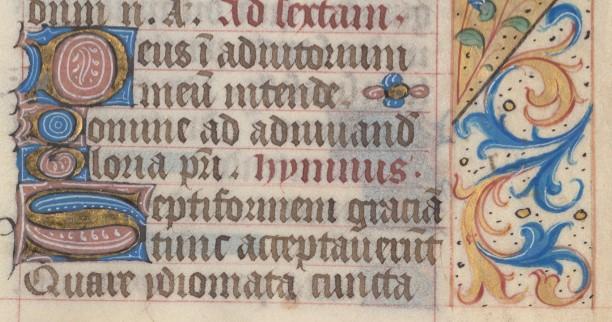Update to offsite collection retrievals
- What's On
- Collections
- Research
- Stories
- Visit us
- About Us
- Get involved

Fragmentarium is an international, online research laboratory for uploading digital copies of fragments from hand-written medieval books, known as manuscripts. This landmark project started at the University of Fribourg, Switzerland, with the intention of providing a digital space for fragments of these precious books, for international study and research. The State Library of South Australia has contributed digital copies of four manuscript fragments to Fragmentarium, joining with institutions such as the Vatican Library, British Library, Harvard University, Bayerische Staatsbibliothek and Biblioteca Nacional.
The ‘fragments’ are single manuscript leaves (pages), that were removed from the original whole works during a monumental change in the evolution of the book, dictated in part by the mechanisation of printing, increased literacy and changes in attitudes towards expensive handmade books.
Decorated medieval manuscripts were usually commissioned by wealthy people and were used for religious purposes. They included Bibles, psalters (collections of the Psalms), prayer books, hymnals and missals (texts for Mass). The pages were made from processed animal skin, such as sheep, goat or calfskin, which were inscribed and illuminated by monks and scholars, using valuable pigments and metals. Besides these personal books there were religious textbooks used by scholars and students which were also produced in monasteries for centuries, though with little or no decoration.

Manuscripts contained conventions which were easily recognised and clearly understood. For example, a large red letter (initial) would indicate the start of an important sentence, much like a newspaper headline.

The level of the complexity of the script and intensity of the decoration depended on how much the buyer could afford to pay. Expensive religious accessories were entirely appropriate, and necessary, indicators of the level of devotion a person held for their faith.

How did the manuscripts become fragmented?
It’s partly to do with the inventor, Johannes Gutenberg. His semi-automated European printing press (c. 1450) and the development of paper enabled the rapid and wider circulation of printed information, which the masses embraced. Eventually, hand-scribed books began to decline in popularity and value. Limners, the monastic and scholarly artists who had illustrated the manuscripts found themselves decorating the pages of printed books.
Some manuscripts were handed down through generations of families. But during the 16th and 17th centuries, thousands of medieval manuscripts were boiled down to produce glue. Heavier pages were cut from the books and used by bookbinders to support the binding of new printed volumes. Medieval manuscripts were also impacted by fire, war, and theft.
Book-breakers, also known as biblioclasts, deliberately purchased medieval manuscripts and cut them up in order to sell individual pages, with the justification that more individuals and libraries could buy a piece of something that no-one could afford whole. This practice, which continued to the 1950s, destroyed the provenance and ‘complete’ nature of the books. Many of the manuscript fragments in the libraries of North America were from the personal collection of art historian and biblioclast Otto F. Ege (1888 - 1951), who took apart damaged manuscript volumes and mounted them specially for sale. The Missal, above, was part of Ege's collection.
Some transient book sellers simply stood on city streets and ripped pages out of manuscripts for passers-by to purchase.

As time went by, attitudes towards these unique medieval texts began to change again. People discovered that book bindings held these valuable fragments and extracted them for study. Modern scholars, libraries, galleries and museums recognised the damage done by past practices and actively sought to acquire remnants of the books for their collections.
The State Library of South Australia acquired some medieval manuscript fragments during the 1980s, as representative samples of the history and evolution of the book, and the different scripts and decorative styles once used. You can see the particular fragments donated to the digital laboratory website @ Fragmentarium.
Now that libraries the world over have collaborated to create digital access to the manuscript pages, researchers can study and compare the fragments. In exceptional cases, scattered fragments from a single work can be ‘virtually reunited’ and examined as a more complete work.
Written by Denise Chapman and Sara Stodart, State Library of South Australia